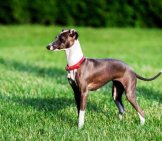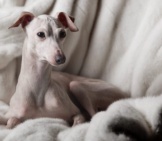The Italian Greyhound is a fragile being that also has all the trimmings of a proper athlete. Bred first and foremost as a companion dog, but also as a small game hunter, this toy breed has been a favorite of the aristocracy for hundreds of years. Small and cuddly, yet lithe and fast, these dogs give lessons in balance. Read on to learn more about the Italian Greyhound.
Description of the Italian Greyhound
These dogs are greyhounds in miniature. They were literally bred for the well-to-do European who wished to have the status symbol associated with owning a tiny version of a popular dog.
Slight and sleek, with very short hair, the Italian Greyhound looks quite fragile. Indeed their spindly legs have been known to break. This is especially true when these active dogs leap from the high perches they tend to prefer.
However, they are also athletic, with a racer’s build. Their curved backs lead to a tail that often sticks between their legs. This breed has a distinctive, high stepping prance.
Their short, smooth coat is soft to the touch, but offers little protection from the elements. These greyhounds surprisingly come in a variety of colors. Blue, black, fawn, and sable are quite common, as well as all of these shades mixed with white.
Life Expectancy and Size
Although not exactly hardy, most Italian Greyhounds can expect to live long lives. Their lifespan usually ranges between 13 and 15 years.
They are relatively tall for their weight – these are not stout dogs, but arching, graceful ones. These miniaturized greyhounds tend to stand between 13 and 15 inches tall, and weigh between 14 and 17 pounds.
Because of their slight frames, it is easy to overfeed this breed. They may gain weight from even a small amount of excess food, including treats and table scraps. This extra weight puts considerable strain on their slight builds.
Generally, the Italian Greyhound’s ribs should not be visible, but palpable, and they should show at least a light outline of the hipbone.
Protective Ability
The Italian Greyhound is perhaps the worst choice for a guard dog. In addition to being tiny, they are also frail and often timid with strangers. Usually, they don’t even bark!
Training
The Italian Greyhound is sensitive, and should be treated as such. They behave best when a consistent, rewards-based training plan is initiated. These dogs tend to need a lot of praise, and will crumble if yelled at or rough-housed. Treats can be helpful, but do not feed too many for fear of causing damaging weight gain.
Although these dogs do not tend to be downright stubborn, they can be tricky. They may avoid commands or find new ways of doing things. Consistent commands followed by copious amounts of praise is the recipe for success.
This breed is also notoriously difficult to potty train. They hate inclement weather, and may refuse to go outside if it is raining or cold. It can be helpful to provide them with a sheltered place to go.
Energy Level
Greyhounds are born to race, and these miniature versions still retain much of their athleticism. They are active dogs, but also immensely enjoy cuddling and curling up on cozy couches.
Again, the mix of toy breed and hound comes out in their personality. Italian Greyhounds often switch quickly between moods. They may go from snoozing on the couch to racing around the house in a matter of seconds.
What Living with an Italian Greyhound is Like
Living with this lovable lap dog can be quite fun. They provide many of the benefits of the toy breeds, with the energy and athleticism of a bigger dog. However, because they’re small in size, it’s easier to get in the exercise they need to stay sane. Plus, they don’t cause so much damage when they do decide to whip around the house!
That being said, this breed is sensitive and fragile. They need owners that understand their special needs. This Greyhound may hurt himself if left unattended and allowed to run and jump as he pleases. This is especially true of young dogs. Kids or inattentive adults may accidentally hurt them.
These dogs crave human attention, and do not like to be left alone for too long. They also may stress out if they have to face rapid or frequent changes in schedule.
Care of the Italian Greyhound
These are fragile dogs that need special handling, like many of the toy breeds. However, with the proper handling, they can thrive as lovely companion dogs.
Environmental Needs
The Italian Greyhound is very sensitive to weather. Their low body fat, short hair, and small size mean that they are absolutely helpless in the extreme cold. They may even refuse to go outside if it begins to rain!
Providing these dogs with a sheltered yard in which to potty is advised. Take proper precautions to keep them warm during the winter. They are probably not suited to environments that become frigid or are cold all year round.
Exercise Needs
These dogs are quite high energy for a toy breed. Still, it is not so difficult to make sure that they stay fit and occupied.
Regular play sessions in a fenced area are usually sufficient. They may also enjoy walks with their owners, but should have at least some room to run. For this reasons, city apartments without access to safe open spaces are not advised.
Generally, Italian Greyhounds do not do very well off leash, because they are quickly distracted. It is also easy for them to get into trouble, including with others dogs. Dog parks may not be the best option for their tiny frames. They are easily damaged.
Shedding and Grooming
This breed has an easy-care coat. They only need sporadic, gentle brushing. Usually, this will work just as well as a bath to get off any dirt they may have gotten into. Their short coat sheds very little.
Some of these dogs have problems with tooth and gum disease. Regular brushing is recommended.
The Italian Greyhound’s nails should be clipped regularly. They are small, so be especially careful to avoid the quick. Their hair-shaped paws require their central nails to be left slightly longer than those on the edges.
Ideal Home Environment
This breed is perfect for the owner looking for a companion The ideal owner will make sure to remain gentle with this sensitive breed. This requires patience and positivity during training. This means extra vigilance when they are young.
Kids or inattentive adults may accidentally hurt this breed, so special care must be taken to protect their fragile bones. Social creatures, they require adequate attention and like routines.
These dogs can be good for small spaces. However, they should have access to a safe place to run around.
Health Concerns
The Italian Greyhound has a long life expectancy, but can still fall victim to a variety of health problems. Bone and joint issues are not uncommon, including broken bones. Watching their activity level and discouraging them from jumping can help avoid issues. It’s also prudent to keep these greyhounds at a healthy weight.
This breed is especially prone to tooth disease. They may also have thyroid problems. Working with a reputable breeder can help to avoid most genetic disorders.
Behavior Problems
These dogs can become stressed when left alone or ignored. This may lead to destructive behaviors like racing or chewing.
Italian Greyhounds can also be escape artists. They are good jumpers, and some like to dig. When off leash, their desire to chase prey can become quite problematic. Good foundations in obedience can be helpful, as well as reasonable risk management.
























![Red Angus Closeup of a beautiful Red Angus cowPhoto by: U.S. Department of Agriculture [pubic domain]https://creativecommons.org/licenses/by/2.0/](https://animals.net/wp-content/uploads/2020/03/Red-Angus-4-100x75.jpg)

